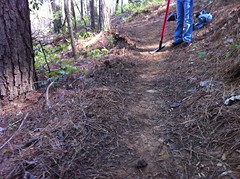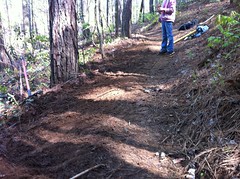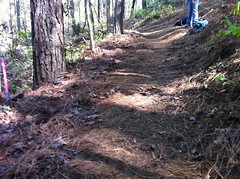Today was work party day at Jake Mountain. I actually drove home from Baton Rouge yesterday so I could make it rather than staying all weekend, which was good because we were a little shorter handed than usual.
We've done finishing work on most of Jake and Moss Branch east of FS28-1, but we still have the section of Jake from the intersection with Moss down to Jones Creek. I've ridden the other sections a few times recently and they appear to be holding up fantastically, and all we've had to do is deberming and nicking, standard stuff.
We are having two bits of trouble though.
The corridor is about 4 feet wide but the trail itself is settling in at about a foot and change. This is great for bikes and hikers but horses prefer a trail closer to two feet wide. The narrowing has mainly occurred as a result of the backslope settling in. When we deberm the trail, it actually reintroduces an inch or two on the outside but at some point we need to go back in and clear a bit of the backslope away. This will be tricky though, I don't want it to pack down below the level of the main trail. We'll have to proceed cautiously there.
Another problem is that when we deberm the trail, it leaves a swath of exposed soil for about a foot on the downslope. There are really two issues with that.
The first is just cosmetic. Any recently worked section looks like a demolition crew just came through. Though the trail needed work, before the work was done, to the untrained eye at least, it looked natural and pretty. Post-work it looks pretty bad for a while, and with the end of winter, we're not likely to get any new leaf litter for a while.
The second issue is that to a horse, and possibly to a fast-moving cyclist, it just looks like the trail is a foot wider. I've seen a few tire tracks in the newly exposed soil but mainly hoof prints. The trail itself is hard and solid but the uncovered soil is soft and it's apparently creating a bit of a problem. Nothing bad has happened yet, but it's possible for a horse to step into the softness and stumble, maybe even fall.
One thing we did today was to cover any newly worked soil that we don't want anyone to ride on.
For example, here was a section of trail that needed to be debermed.

Here it is post-deberming.

And here it is, all covered up.

Upon re-covering, it's really obvious where you should go and where you shouldn't go. Hopefully this will be sufficient. Only time will tell.
We got maybe a third of a mile done today, and not even totally done. I always want to do full-on deberming of the entire length of the trail but we just didn't have enough hands for that and we ended up focusing on the bottoms of the grade reversals. One of them even had a tree on the upslope and needed a ton of work, including some rock armoring.
Ideally we need to run a blade all the way down the edge of the trail. I can even thing of some spots that we've worked already that could use that treatment. I'm not sure you can realistically even get a dingo in there though. The hand-deberming is very effective, it just takes forever. I've used a tiller to do that kind of work in my yard before and it always seemed like it might be the perfect low-impact trail sculpting tool. It would take off the edge as well as a pulaski in a tenth of the time, with a hundredth of the effort and somebody could just follow behind with a fire rake and a MacLeod like we do now. I can think of a couple of other uses for it too. I wonder if I'd need all of the different certifications to run a tiller in the National Forest. I'll have to find out.



No comments:
Post a Comment